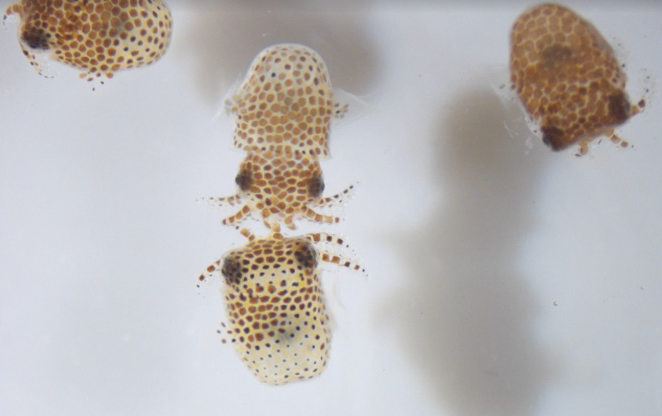Understanding of Microgravity on Animal-Microbe Interactions (UMAMI)
Science Objective
Understanding of Microgravity on Animal-Microbe Interactions (UMAMI) examines the effects of spaceflight on the molecular and chemical interactions between beneficial microbes and their animal hosts. Gravity’s role in shaping these interactions is not well understood and microgravity provides the opportunity to improve that understanding. Results could then be applied to the better understanding of human physiology in the space environment. The project uses a simplified symbiosis between the bobtail squid Euprymna scolopes and its symbiotic bacterium Vibrio fischeri. The luminescent bacteria colonize a specialized light organ within the squid causing the squid to “glow-in-the-dark”.
Status
Experiment will launch to the International Space Station on SpaceX-22 Commercial Resupply Service mission on June 3, 2021.
Experiment Description
The overall goal of the Understanding of Microgravity on Animal-Microbe Interactions (UMAMI) investigation is to examine the effects of spaceflight on beneficial interactions between microbes and animals. The investigation uses a model animal system, the bobtail squid Euprymna scolopes, and its symbiotic bacterium Vibrio fischeri, to ascertain how microbes colonize and influence the development of the animals.
Flight experiment overview: Specifically, newly hatched squid paralarvae that have never been exposed to bacteria are flown in the ADvanced Space Experiment Processor (ADSEP) hardware aboard the SpaceX CRS-22 Dragon spacecraft. Once in space, the symbiotic bacteria are added to a cohort of the squid paralarvae to colonize a special organ in the squid called the light organ. Using the automated flight hardware, a subset of animals are preserved over time to capture the changes that the bacteria are causing in the host animal under spaceflight conditions. As a control, there is a cohort of animals in the ADSEP hardware that are exposed to microgravity but are maintained aposymbiotically, or without bacteria. The onset of the symbiosis is monitored for 12 hours, at which all animals are preserved, and all paralarvae are moved to the freezer, until return to Earth. The preserved tissues are examined at the molecular level to examine how the transcriptome, or all the genes expressed at a given moment, have changed in the space environment under the presence or absence of their symbiotic bacteria.
Implications of the research outcomes: First, by examining how healthy animal-microbe interactions are initiated and maintained under microgravity conditions, the sensitivity of these associations to perturbations in the space environment can be determined. There is a gap in the understanding of the effects that the space environment has on the microbiome of animals. As there are more than 2,000 identified bacterial species that form associations with humans, there are fewer than 100 species identified as human pathogens, yet most microgravity studies have focused on pathogens. This leaves a large array of undescribed, beneficial microbes that form interactions with animal cells which may, or may not, be impacted by microgravity conditions. Here in this project, the question of how does microgravity alter key bacteria-induced developmental events within the host animal at the molecular level is asked. In other words, what happens to mutualistic associations when gravity is removed? Secondly, by removing gravity as a constant, the question of whether gravity obscures aspects or cues of bacteria-induced animal development that may otherwise go undetected under terrestrial conditions can be addressed. These new insights from simplified animal model systems can then be applied to the better understanding of human physiology in the space environment.
Related Links
Space Station Research Explorer - UMAMI


































